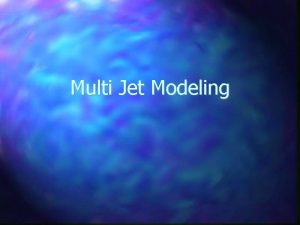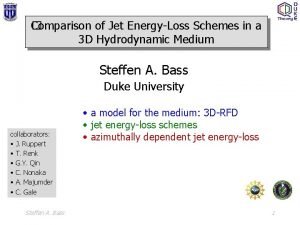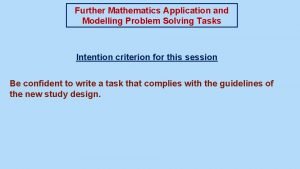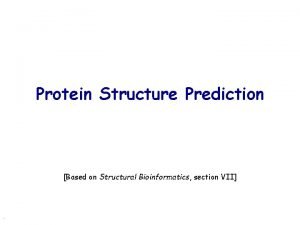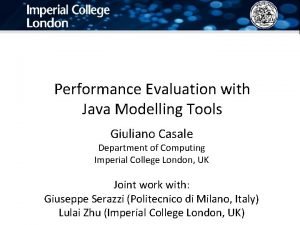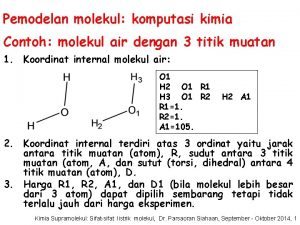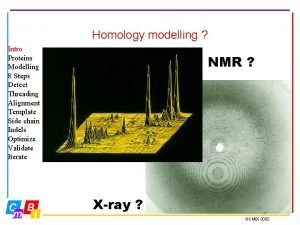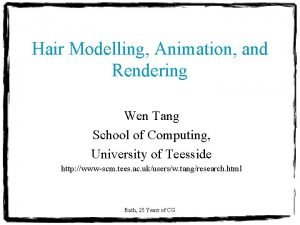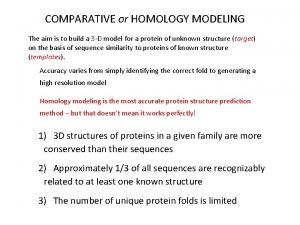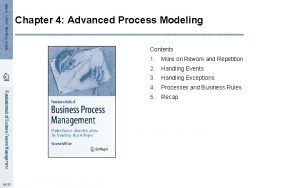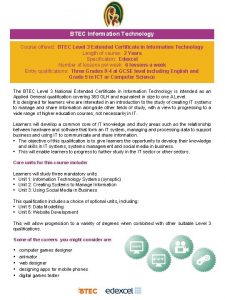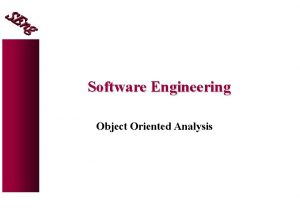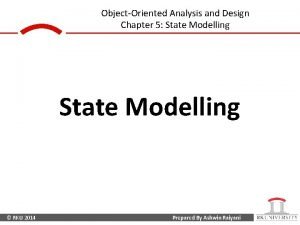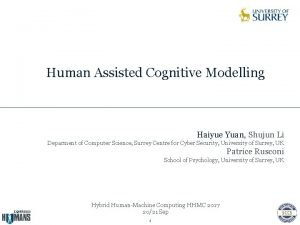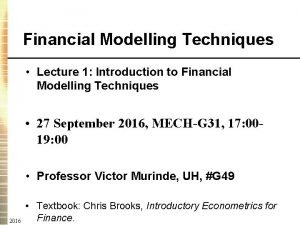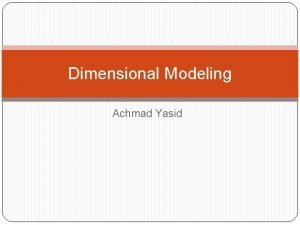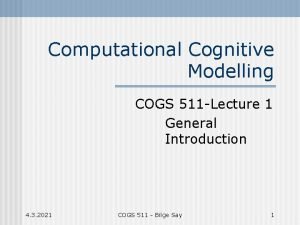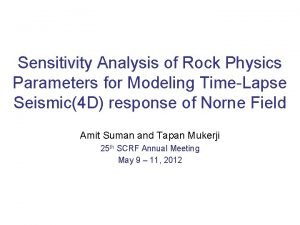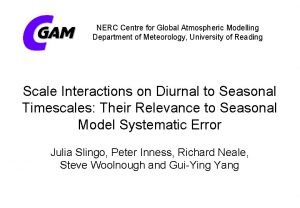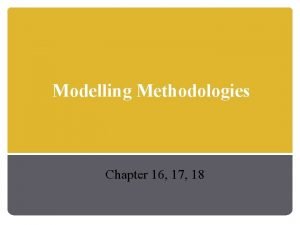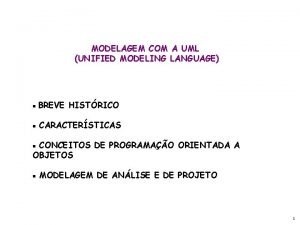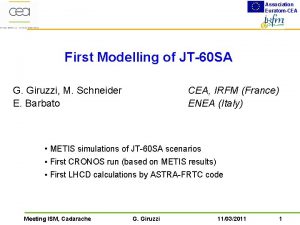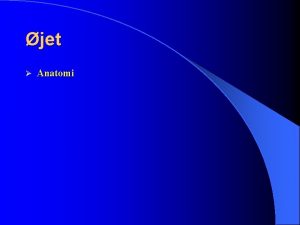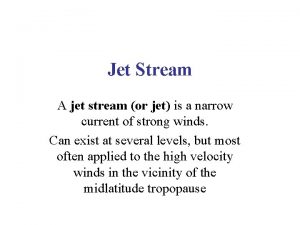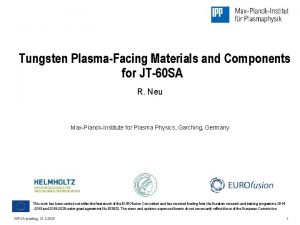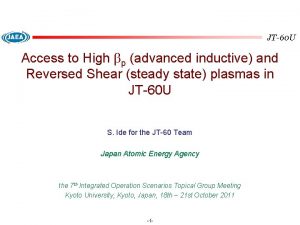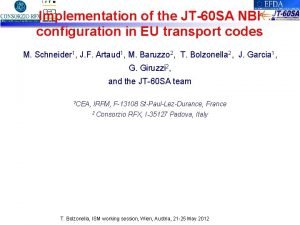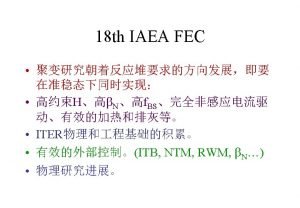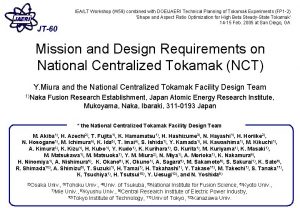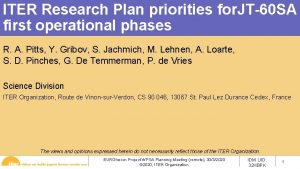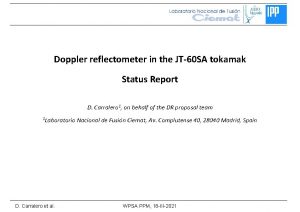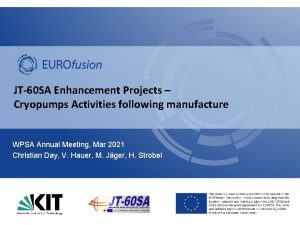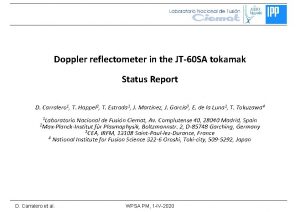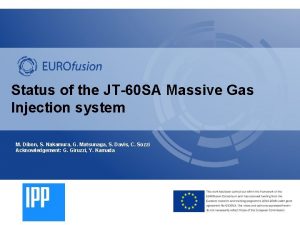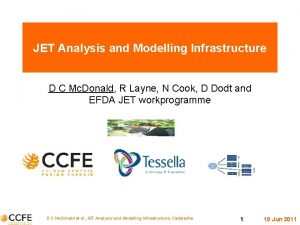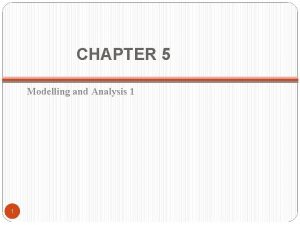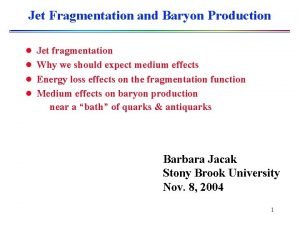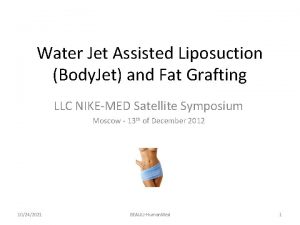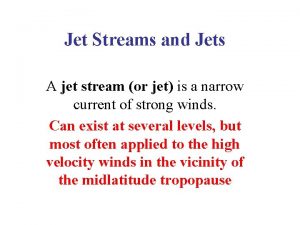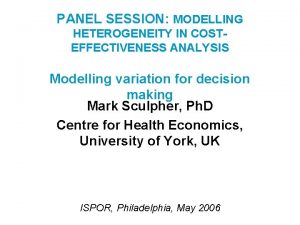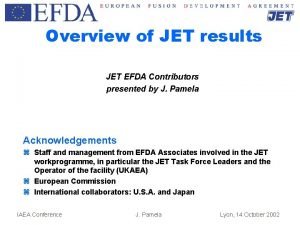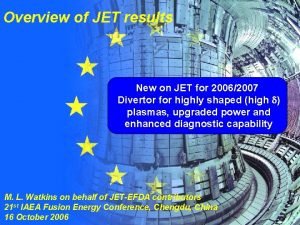ANALYSIS AND MODELLING OF JET AND JT60 U








































- Slides: 40

ANALYSIS AND MODELLING OF JET AND JT-60 U DISCHARGES J. Garcia 11 March 2013 CEA | 10 AVRIL 2012 | PAGE 1

Context Main goal: Modeling of JET and JT-60 U plasmas towards full JT-60 SA scenarios simulations • Analyze key physics similarities and differences between both devices • Benchmark of JA and EU codes and models on discharges of both tokamaks. • Predictive and interpretative simulations of JET and JT-60 U plasma scenarios using both the EU and JA suites of codes. • Find predictive capability of three transport models: glf 23, Bohm-Gyro. Bohm and CDBM • Use this information to design JT 60 SA scenarios ISM Garching | 11 March 2013 | PAGE 2

Framework • Benchmark of heat transport models has been carried out with TOPICS and CRONOS using fixed profiles JT-60 U discharges • Predictive temperatures profiles calculated with the same transport models with both codes • The experimental density is taken from experiment • Temperatures and densities at the pedestal taken as boundary conditions • q profile obtained from MSE measurements when possible • NB profile (heating and pressure) calculated by F 3 D-OFMC and SPOT including fast ion density and pressure profiles • Experimental toroidal rotation • Predictive capabilities of transport models for temperatures have been also tested with CRONOS using JET discharges • Physical analysis of the results done ISM Garching | 11 March 2013 | PAGE 3

Framework • Final goal is predicting JT-60 SA scenarios… • …so the complexity of the simulations has been increased: particle transport, current diffusion, and pedestal pressure also included • JET and JT-60 U discharges simulated this way • Best combination of models for predicting both devices discharges is proposed • With this scheme some JT-60 SA predicitve simulations will be carried out • The results give an operational window of the expected performance for JT-60 SA ISM Garching | 11 March 2013 | PAGE 4

Analysis of Physics differences and similarities between JT-60 U and JET: state of knowlegde CEA | 10 AVRIL 2012 | PAGE 5

Analysis of Physics differences and similarities between JT-60 U and JET: Current Diffusion • Two hybrid discharges compared: JET 75225 and JT-60 U 48158 • q profile evolution well simulated for JET hybrid 75225 during flat-top phase. • For JT-60 U hybrid 48158, stationary solution with neo-classical resistivity cannot explain q profile • Fixed MSE measured q profiles (when available) are used for JT-60 U predictive simulations ISM Garching | 11 March 2013 | PAGE 6

Analysis of Physics differences and similarities between JT-60 U and JET: Fast ions Discharge JT-60 U #48158 JET #75225 Ip (MA) 0. 9 1. 7 Bt (T) 1. 5 2. 0 q 95 3. 0 4. 1 κ/δ 1. 40/0. 33 1. 64/0. 23 βN/βp 2. 6/1. 50 3. 0/1. 30 f. Gw 0. 5 0. 45 H 98(y, 2) 1. 1 1. 30 Pnbi(MW) 7. 5 17 Wfast/Wdia 45% 35% • Fast ions contribution to the total pressure is very important for hybrid scenarios in JT-60 U and in some JET shots. Can reach up from 35% up to 45% of the total pressure • The fast ion pressure effect is included in the CDBM model. The original heat diffusivities are mended ISM Garching | 11 March 2013 | PAGE 7

Analysis of Physics differences and similarities between JT-60 U and JET: Turbulence • Turbulence regimes analyzed with TGLF with Miller geometry and electromagnetic effects • For JET 75225 ITG modes dominate the plasma core. TEM appear close to the pedestal region • Due to the high density peaking of the JT-60 U shot 48158, TEM appear at ρ=0. 5 ISM Garching | 11 March 2013 | PAGE 8

JT-60 U and JET H-modes CEA | 10 AVRIL 2012 | PAGE 9

H mode shots Discharge q 95 κ/δ Bt (T) βN n/n. Gw Ip (MA) Pin (MW) H-mode JT-60 U #33655 3. 0 1. 53/0. 16 3. 1 1. 1 0. 48 1. 8 10 H-mode JT-60 U #33654 3. 0 1. 53/0. 16 3. 1 1. 0 0. 40 1. 8 8 H-mode JET #73344 3. 5 1. 75/0. 40 2. 7 1. 5 0. 75 2. 5 12 H-mode JET #74175 2. 7 1. 68/0. 21 3. 0 1. 5 0. 55 3. 8 25 • Wide range of H mode discharges selected for both devices • Differences on plasma parameters allow to check the goodness of the models for extrapolation ISM Garching | 11 March 2013 | PAGE 10

JT-60 U H-mode: 33654 • Low density H-mode with a relatively high population of fast ions • Density peaking is low • CRONOS and TOPICS give very similar results • CDBM and GLF 23 give lower Te. BGB right. • GLF 23 and BGB give very good ion temperature agreement, CDBM gives slightly lower ISM Garching | 11 March 2013 | PAGE 11

JT-60 U H-mode: 33654 • Density is simulated with GLF 23. Density pedestal is fixed to experimental value • Only NBI particle source considered • Density is simulated with reasonable agreement(slightly more peaked) • Temperature profiles are similar than fixed density simulations, • Sligltly lower central temperature obtained due to higher central density. ISM Garching | 11 March 2013 | PAGE 12

JT-60 U H-mode: 33655 • High density H-mode with a low population of fast ions • Very flat density profile • Three transport models tend to agree with experimental data • Agreement is better for GLF 23. • Agreement between CRONOS and TOPICS ISM Garching | 11 March 2013 | PAGE 13

JT-60 U H-mode: 33655 • Density is simulated with GLF 23. Density pedestal is fixed to experimental value as done for shot 33654 • Only NBI particle source considered • Density is simulated with reasonable agreement (again slighlty more peaked close to axis) • Sligltly lower temperature obtained compared to fixed profile simulations. • Some problems at the edge appear. ISM Garching | 11 March 2013 | PAGE 14

JET H-mode: 73344 • JET H mode with high triangularity and density (and high pressure pedestal) and relatively low current Ip=2. 5 MA • As it happens in JT-60 U, density is not highly peaked • Three models are in reasonable agreement with experiment • GLF 23 is the one closest to experimental data • No model for the sawteeth considered ISM Garching | 11 March 2013 | PAGE 15

JET H-mode: 73344 • Density is simulated with GLF 23 and CDBM+GLF 23(for density). • Density pedestal is fixed to experimental value by assuming that turbulent transport is reduced to neoclassical levels • Only NBI particle source considered • Density is simulated with reasonable agreement mainly for just GLF 23. • The combination of CDBM+GLF 23 sligtly overstimates density. • Temperatures are in agreement with experimental data mainly for GLF 23 ISM Garching | 11 March 2013 | PAGE 16

JET H-mode: 74175 | PAGE 17

Conclusion on H mode simulations • Good agreement between TOPICS and CRONOS when simulating JT-60 U shots • In general temperatures are well simulated for the transport models considered for JT-60 U and JET • GLF 23 tends to slightly overstimate density peaking but profile is close to experimental data for both devices • For H-modes scenarios on JT-60 SA GLF 23 should be used with priority ISM Garching | 11 March 2013 | PAGE 18

JT-60 U and JET Hybrids CEA | 10 AVRIL 2012 | PAGE 19

Hybrid shots Discharge q 95 κ/δ Bt (T) βN/βp n/n. Gw Ip (MA) Pin (MW) Hybrid JT-60 U #48158 3. 2 1. 40/0. 33 1. 5 2. 6/1. 5 0. 50 0. 9 7. 5 Hybrid JET #77922 4. 3 1. 7/0. 38 2. 3 2. 7/1. 2 0. 70 1. 7 17 Hybrid JET #75225 4. 1 1. 64/0. 24 2. 0 3. 0/1. 3 0. 45 1. 7 17 • Typical advanced scenarios selected for both devices. • JT-60 U shot 48158 is a standard high Beta-p advanced shot obtained in that device • High performance sustained for 27 s with low density and high central NBI power • JET hybrid shots 75225 and 77922 are representative of low delta/low density and high delta/high density carbon hybrid scnearios ISM Garching | 11 March 2013 | PAGE 20

JT-60 U Hybrid : 48158 • Broad region of flat q profile with very high density peaking • Very low rotation. • General good agreement between TOPICS and CRONOS • Flat temperature regions obtained with GLF 23 w/o EXB. • Including EXB effect, αEx. B=1. 35, these regions disappear. • GLF 23 give good Te profiles but highly overstimates Ti. • Temperatures obtained with CDBM are slightly lower than experimental but closer than GLF 23 for ions. ISM Garching | 11 March 2013 | PAGE 21

JT-60 U Hybrid : 48158 • Density is simulated with GLF 23. Density pedestal is fixed to experimental value by reducing diffusivity to neoclassical value. • Only NBI particle source considered • Temperatures are simulated with both CDBM and GLF 23. • Density is simulated with reasonable agreement for both models • Temperature profiles are similar than fixed density simulations, including EXB. • The ion temperature is much beter simulated with CDBM | PAGE 22

JET Hybrid : 77922 • Broad region of flat q profile with high density peaking higher than H-modes but lower than JT-60 U case • Low fraction of fast ions and very high pedestal pressure • Good Te obtained from GLF 23. CDBM and BGB slightly deviate from experimental data • BGB and GLF 23, with αEx. B=1. 35, highly overstimate ion temperature. • CDBM give good Ti profile. | PAGE 23

JET Hybrid : 77922 • Density is simulated with GLF 23. Density pedestal is fixed to experimental value by reducing diffusivity to neoclassical value. • Only NBI particle source considered • Temperatures are simulated with both CDBM and GLF 23. • Density is simulated with reasonable agreement for both models • Both models give slighlty lower temperatures than in fixed density case. ISM Garching | 11 March 2013 | PAGE 24

JET Hybrid : 75225 • Broad region of flat q profile with high density peaking higher than H-modes and close to the JT-60 U case • Very high fraction of fast ions • All models are close to experimental data, mainly for ions with GLF 23 and CDBM for electrons. ISM Garching | 11 March 2013 | PAGE 25

JET Hybrid : 75225 • Density is simulated with GLF 23. Density pedestal is fixed to experimental value by reducing diffusivity to neoclassical value. • Only NBI particle source considered • Temperatures are simulated with both CDBM and GLF 23. • Density is simulated with reasonable agreement for both models • Temperatures similar to the ones obtained in fixed density simulations. ISM Garching | 11 March 2013 | PAGE 26

CONCLUSIONS ON HYBRID SCENARIOS • Good agreement between TOPICS and CRONOS when simulating JT-60 U shot 48158 • The agreement of CDBM for advanced scenarios tend to be higher than GLF 23 • The combination of CDBM for heat transport and GLF 23 for particule transport seems to be a good choice for the extrapolation of advanced scenarios to JT-60 SA ISM Garching | 11 March 2013 | PAGE 27

Physics analysis of results: Role of fast ions and Ex. B shear on advanced scenarios CEA | 10 AVRIL 2012 | PAGE 28

PHYSICS ANALYSIS: IMPACT OF FAST IONS ON ADVANCED SCENARIOS • The impact of fast ions is analyzed for hybrid scenarios JET 75225 and JT 60 U 48158 • The original version of the CDBM is compared to the one used in this study • For both discharges the temperatures obtained with the original model highly deviate from experimental data • This shows the importance of fast ions on hybrid scenarios. • More systematic analysis will be carried out ISM Garching | 11 March 2013 | PAGE 29

PHYSICS ANALYSIS: IMPACT OF EXB SHEAR ON ADVANCED SCENARIOS • The impact of Ex. B is analyzed in shot 75225. • The density profile almost does not change. • Temperature decreases and deviates from experimental data. • Temperature pedestal is kept fixed. Full simulation (including pedestal dynamics) is necesasry to full understand the process. ISM Garching | 11 March 2013 | PAGE 30

PHYSICS ANALYSIS: IMPACT OF EXB SHEAR ON ADVANCED SCENARIOS • The impact of Ex. B is analyzed in JT-60 U shot 48158. • Unlike in the fixed density case, when density is simulated, no flat temperature regions appear. • The density profile tends to be less peaked. • Temperature decreases and deviates from experimental data in the palsma core , mainly for electrons. But this effect is not very strong • The trend is similar to the JET shot. ISM Garching | 11 March 2013 | PAGE 31 • Fast ions seem to be more important is this kind of discharges

Fully self-consistent simulations CEA | 10 AVRIL 2012 | PAGE 32

Fully self-consistent simulations • Self consistent simulations perfomed with CRONOS for 2 Hmodes and 2 hybrids discharges form JET and JT-60 U • Current diffusion+ heat and particule transport+ pedestal height calculated • All sources calculated • Sawteeth model applied when possible for H-modes • GLF 23 transport model applied for turbulent particle transport • Density pedestal obtained by reducing turbulent transport to neoclassical transport • Pedestal temperature obtained by using Cordey scaling for the energy content of the pedestal • CDBM and GLF 23 models applied for heat transport ISM Garching | 11 March 2013 | PAGE 33

Fully self-consistent simulations: JT-60 U 33654 • Density is reasonably well simulated by using this scheme but always more peaked with both models • Pedestal temperatures are close to experimental data • Temperatures a slightly understimated by using CDBM ISM Garching | 11 March 2013 | PAGE 34

Fully self-consistent simulations: JET 73344 • Very well pedestal features obtained both for density and temperatures • Again GLF 23 is better than CDBM ISM Garching | 11 March 2013 | PAGE 35

Fully self-consistent simulations: JT-60 U 48158 • No current diffusion made for this shot • Density is reasonably well simulated by using this scheme. • With GLF 23 density peaking is similar to experimental data • Electron temperature similar for both models • Ion temperature much better for CDBM • Pedestal is well simulated ISM Garching | 11 March 2013 | PAGE 36

Fully self-consistent simulations: JET 75225 • Density is reasonably well simulated by using this scheme altough a bit better for GLF 23 • Temperatures are reasonably well simulated ISM Garching | 11 March 2013 | PAGE 37

Conclusions CEA | 10 AVRIL 2012 | PAGE 38

CONCLUSIONS • Physics analysis of JET and JT-60 U discharges done • Sistematic becnhmark with TOPICS using JT-60 U shots done with good agreement • GLF 23 model has best results for H-modes for JET and JT-60 U • CDBM starts to be better for advanced regimes (hybrids) • Scenarios with ITB will be also analyzed • Full simulations of current, heat+particle transport+pedestal height done • This type of simulation allows physics sensitivity analysis which will be carried out in the future • Using CDBM and GLF 23 give a region of confidence for the extrapolation to JT-60 SA ISM Garching | 11 March 2013 | PAGE 39

I ISM Garching | 11 March 2013 | PAGE 40
 Multi-jet modeling
Multi-jet modeling Yelvington jet aviation jet fuel
Yelvington jet aviation jet fuel Structured analysis tools
Structured analysis tools Jet analysis
Jet analysis Jet analysis
Jet analysis Define geometric modelling
Define geometric modelling Trendlines and regression analysis
Trendlines and regression analysis Problem solving and modelling task example
Problem solving and modelling task example What is technological modelling
What is technological modelling Homology modelling steps
Homology modelling steps Jsimgraph
Jsimgraph Molecular modelling laboratory
Molecular modelling laboratory Modelling madness
Modelling madness Richer interaction in hci
Richer interaction in hci Lbo model case study
Lbo model case study Homology modelling steps
Homology modelling steps Hair modelling
Hair modelling Objective of edlc
Objective of edlc Homology modelling steps
Homology modelling steps Advanced process modelling
Advanced process modelling Mathematical modeling of electrical systems examples
Mathematical modeling of electrical systems examples Flight level
Flight level Unit 5 data modelling assignment 2
Unit 5 data modelling assignment 2 Algorithmic cost modelling
Algorithmic cost modelling Class responsibility collaborator modelling
Class responsibility collaborator modelling State modelling
State modelling Sequence diagram penarikan uang di atm
Sequence diagram penarikan uang di atm An introduction to model-based cognitive neuroscience
An introduction to model-based cognitive neuroscience Cognitive modelling
Cognitive modelling Types of financial modelling techniques
Types of financial modelling techniques Menurut anda apa tujuan dari dimensional modelling....?
Menurut anda apa tujuan dari dimensional modelling....? Data modelling techniques in business intelligence
Data modelling techniques in business intelligence Malatesta's modelling e.g. by mother
Malatesta's modelling e.g. by mother Cognitive modelling
Cognitive modelling Bim introduction ppt
Bim introduction ppt Sd3 security framework
Sd3 security framework Rock physics modelling
Rock physics modelling Modelling
Modelling Data modelling methodologies
Data modelling methodologies Relacionamentos uml
Relacionamentos uml Disease modelling
Disease modelling
